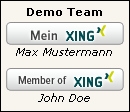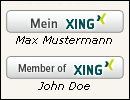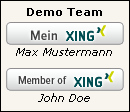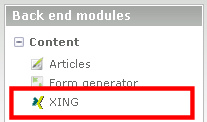Difference between revisions of "Xing"
From Contao Community Documentation
(→Using) |
m (→Using) |
||
| Line 79: | Line 79: | ||
First, create a new category. In the category create the Xing profile(s).<br /> | First, create a new category. In the category create the Xing profile(s).<br /> | ||
Then, create a front end module and build it into the layout of the page.<br /> | Then, create a front end module and build it into the layout of the page.<br /> | ||
| − | Here are the steps, each with the default values. | + | Here are the steps, each with the default values. [[Xing#Technical_Details|Technical details]] will be explained later. |
==Create the category== | ==Create the category== | ||
| Line 91: | Line 91: | ||
Now, either click the 'New profile' and then the arrow icon, or click the plus in the head of the category: <br /> | Now, either click the 'New profile' and then the arrow icon, or click the plus in the head of the category: <br /> | ||
[[File:Xing_en_backend_profil_neu.jpg|Xing - neues Profil]]<br /><br /> | [[File:Xing_en_backend_profil_neu.jpg|Xing - neues Profil]]<br /><br /> | ||
| − | + | Now, some information are needed: | |
| − | * XING | + | * XING Profile, e.g.: John_Doe, Explanations in the Help (Help Wizard) |
| − | * XING Layout | + | * XING Layout , Explanations in the Help (Help Wizard) |
| − | * " | + | * activate "Published" |
| − | + | Then you click on "Save and close". | |
| − | == | + | ==Front end Module== |
Ein neues Frontend Modul wird angelegt über: | Ein neues Frontend Modul wird angelegt über: | ||
* Layout -> Themes -> Frontend Module -> Neues Modul (Contao ab 2.9) | * Layout -> Themes -> Frontend Module -> Neues Modul (Contao ab 2.9) | ||
Revision as of 15:20, 19 August 2010
| |
Incomplete Article: This article is not finished yet and needs expansion.
Please expand it and remove this notice when it is finished. |
I'm not a native English speaker. Please correct my mistakes.
But my aim was:
- to select the image
- to determine the position
- several of them on one side, or distributed on several domains.
First, categories are created, in these categories then the XING profile(s). With the XING-Lister, you can select the category that are used. Each front-end module can be assigned their own template. Three different templates are included. (see "Using")
Thus, it is then possible, the categories to distribute on several layouts or several domains. Are there more than one profile in a category, all profiles will be shown from this category. Thus it would be e.g. possible to show the profiles of a whole team.
| Extension-Overview | |
|---|---|
| Name of the developer | Glen Langer (BugBuster) |
| Developer Website | http://www.contao.glen-langer.de |
| Version of the extension | 2.0.0 |
| Compatibility with Contao Version | ab 2.9 |
| Compatibility with TYPOlight Version | 2.7.0 - 2.8.4 (see Installations notes) |
| Link to Extension Repository | http://www.contao.org/extension-list/view/gl_xing.html |
| Donate the developer | Cappuccino |
| Link to Tracker | http://dev.typolight-forge.org/projects/xing/issues |
| Comment | Version for Contao 2.9.0 online |
Forum
Questions about the Xing module will be answered in forum:
English: Forum
German: Forum
Errors and requests can be reported in the Issue Tracker.
Installation
The installation of the module occurs about the extension Repository in back end of Contao.
A manual installation is possible. Download the ZIP file from Extension Repository, unzip and transfer it.
A directory should have been created "/system/modules/gl_xing".
Then call /contao/install.php - Perform Update Database.
( /typolight/install.php in older TYPOlight installations )
Note for older "TYPOlight" versions
TYPOlight 2.8
Users of TYPOlight 2.8.x, please use XING module 1.1.1! (Direct Link)
TYPOlight 2.7
Users of TYPOlight 2.8.x, please use XING module 1.0.4! (Direct Link)
Xing Update version 1.x to version 2.x
What is to be observed, can be found here.
Overview
The Xing module contains a back end and a front end module.
In the back end, there are "Xing", for the front end "Xing list".
Back end
Frontend
For the front end module, a CSS file is included as an example:
- mod_xing_fe.css for a normal, line-by-line output.
Xing Banner
The simplest variant, only the linked image:
![]()
The more complex variant, several Xing banner of a team, with team name and names of team members.

Using
First, create a new category. In the category create the Xing profile(s).
Then, create a front end module and build it into the layout of the page.
Here are the steps, each with the default values. Technical details will be explained later.
Create the category
To create a new category, just click on the left in the back end in 'content' to 'Xing'. In the main area click on the button 'New category'.
Xing - New category
There, enter the name of the category. The front end module will later use this name. Then you click on "Save and close.
Now you can see the category overview. By clicking on the pencil in the line of the category and repeated clicking on the pencil in the head of the category you return to the settings of the category.
Create Xing Profil
In the category list now clicking on Edit (pencil) of the category.
Now, either click the 'New profile' and then the arrow icon, or click the plus in the head of the category:
Xing - neues Profil
Now, some information are needed:
- XING Profile, e.g.: John_Doe, Explanations in the Help (Help Wizard)
- XING Layout , Explanations in the Help (Help Wizard)
- activate "Published"
Then you click on "Save and close".
Front end Module
Ein neues Frontend Modul wird angelegt über:
- Layout -> Themes -> Frontend Module -> Neues Modul (Contao ab 2.9)
- Layout -> Module -> Neues Modul (TYPOlight bis 2.8.x)
Als erstes unbedingt zuerst den Titel eingeben, erst dann bei Modultyp: 'Xing' - 'Xing Anzeige' auswählen. Es ändern sich nun die Formularfelder.
Bei 'Xing Kategorie' nun die vorher angelegte Kategorie auswählen, anschließend 'Speichern und Schließen'.
Nun muss das angelegte Frontend Modul noch im Layout eingebunden werden:
- Layout -> Themes -> Seitenlayout -> Edit des genutzte Layouts (Contao ab 2.9)
- Layout -> Seitenlayout -> Edit des genutzte Layouts (TYPOlight bis 2.8.x)
Bei 'Eingebundene Module' das gerade erstellte Frontend Modul einbinden (z.b in left)
CSS-Datei
Wie bereits erwähnt, wird für die Darstellung eine CSS-Datei mitgeliefert. Für die ersten Tests sollte die Datei mod_xing_fe.css aus dem Verzeichnis /system/modules/gl_xing kopiert werden nach /tl_files und dann über das Backend importiert und im Layout aktiviert werden.
Technical Details
Feinheiten sind innerhalb der Kategorie sowie im selbst angelegtem Frontend Modul machbar/einstellbar.
Feinheiten innerhalb der Kategorie
Team Profile
In den Einstellungen in der Kategorie selbst gibt es nichts weiter, aber man kann in der Kategorie mehrere Xing-Profile anlegen.
Einsatz wäre z.B. eine Übersicht von allen Team Mitgliedern.
Je nach Template Auswahl im Frontend-Modul wird der Kategorie-Name zum Team-Name.
Sie nächsten Abschnitt wie das Ganze dann aussehen kann.
Feinheiten in der Frontend Modul Definition
Templates
Ist nur ein Xing-Profil in der Kategorie definiert, sind folgende zwei Templates sinnvoll einzusetzen:
- mod_xing_list , es wird nur die verlinkte Grafik gezeigt

- mod_xing_list_profile, es wird die verlinkte Grafik gezeigt, darunter der Profile Name (Unterstrich wird dabei entfernt)

Sind mehrere Xing-Profile in der Kategorie definiert um ein Team darzustellen, sind folgende zwei Templates sinnvoll einzusetzen:
- mod_xing_list_profile, es werden untereinander die verlinkten Grafiken angezeigt, jeweils darunter der Profile Name (Unterstrich wird dabei entfernt)

- mod_xing_list_team, wie bei mod_xing_list_profile, zusätzlich erscheint über der ersten Grafik der Team-Name (Kategorie Name)

Sie können eigene Templates im Ordner /templates bzw. im Template Ordner des verwendetem Themes speichern.
Templates müssen mit mod_xing_list beginnen und die Dateiendung .tpl haben. ( z.B.: mod_xing_list_club66.tpl )
Nur Gästen anzeigen
Nach dem Aktivieren der Funktion wird das Modul versteckt, sobald ein Mitglied (Frontend Nutzer) angemeldet ist.
Modul schützen
Hier kann nun definiert werden, dass die Anzeige des Moduls nur dann erfolgt, wenn Mitglieder bestimmter Gruppen angemeldet sind.

